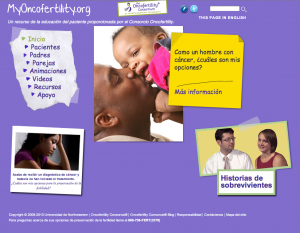 Cancer patients and their loved ones must make an incredible number of important decisions upon diagnosis. It’s a time of extreme stress and emotions run high. Not only do they have to absorb the shock of a cancer diagnosis, they also have to navigate through the world of treatment options. Since many treatment options can harm a cancer patient’s fertility, it is essential to inform them of such risks to provide them with the greatest number of options for later fertility.
Cancer patients and their loved ones must make an incredible number of important decisions upon diagnosis. It’s a time of extreme stress and emotions run high. Not only do they have to absorb the shock of a cancer diagnosis, they also have to navigate through the world of treatment options. Since many treatment options can harm a cancer patient’s fertility, it is essential to inform them of such risks to provide them with the greatest number of options for later fertility.
MyOncoferility.org was conceived to meet the needs of young cancer patients and their loved ones through patient education. Since fertility preservation may be neglected in the initial discussions following a cancer diagnosis, it was important to create a tool that patients could utilize to learn more about their fertility options. It’s also a resource that can be used in conjunction with the information they receive from their health care provider. At the time of diagnosis, patients must absorb a great deal of information on oncology and may feel overwhelmed by the thought of tackling yet another major life decision, such as fertility, when it’s presented to them. In those situations, MyOncofertility.org provides a resource for these patients to learn about their fertility options in a easy-to-understand way.
MyOncofertility.org was designed with the knowledge that patients may be operating on information overload after a cancer diagnosis. As individuals navigate through the site, information progresses from simple to complex per the users request –allowing them to control the browsing experience. MyOncofertility.org also features the testimonials of survivors and relatives of cancer patients in an attempt to foster solidarity through shared experience. One of the motivations for the website was to help users identify with others under similar circumstances to alleviate the feeling of isolation that often comes with a cancer diagnosis. Testimonials can be particularly useful for children, individuals with poor literacy and those with impaired vision, reaching a broader audience. Finally, Myoncoferitlity.org employs a Q & A model to create an interactive learning experience that mimics the face-to-face dialogue, which might occur between a provider and patient. A follow-up question and answer process is then initiated and users are presented with additional resources to look into if they desire more information.
MyOncofertility.org is a fluid project that is constantly evolving to keep in step with technology and meet the needs of users. In September 2011, MyOncofertility.org also introduced a Spanish language version to make the website more accessible to a larger constituency. To learn more about MyOncofertility.org please click here. You can also learn about how the project got started in “MyOncofertility.org: A Web-Based Patient Education Resource Supporting Decision Making Under Severe Emotional and Cognitive Overload,” authored by Kemi Jona and Adam Gerber and found in Oncofertility: Ethical, Legal, Social and Medical Perspectives.

